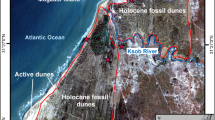Abstract
“Ejin Section” found in a typical vegetation-covered sand dune in Ejin Oasis was investigated. In this study, 263 samples were taken from the section for grain-size analysis, 25 for chemical analysis, 11 for 14C dating and 6 for scanning electron microscope (SEM). The results of the study indicate that 3 types of the sediments in the section can be identified, YS, LS and ST. YS, homogeneous yellow-brown dune sands, is equal to those of inland deserts, LS, loess-like sandy soils, is the same as the sandy loess in the middle Yellow River and modern falling dusts, and ST, sandy sediments interbeded with the deadwood and defoliation of Tamarix spp, represents the depositional process of the section interrupted by abrupt changes in climate. The Ejin Section has recorded the repeated dust-storms or sandstorms since 2500 yr BP and the peak periods of the dust-storms or sandstorms revealed by the section are consistent with the records of “dust rains” in historical literatures, indicating that the change of climate is a key factor to increase sandstorms or dust-storms, whereas, “artificial” factor may only be an accelerating one for desertification.
Similar content being viewed by others
References
Branch of Earth Science, Chinese Academy of Sciences, 1996. An emergent suggestion of retrieving Ejin Oasis. Advance in Earth Sciences, 11(1): 56. (in Chinese)
Compilation Committee of Ejin Banner Chorography, 1998. Ejin Banner Chorography. Beijing: Chronicles Press, 47–120. (in Chinese)
Fan Zili, 1993. A study of the formation and evolution of oases in Tarim Basin. Acta Geographica Sinica, 48(5): 421–427. (in Chinese)
Gao Quanzhou, Dong Guangrong, Li Baosheng et al., 1995. Evolution of southern fringe of Badain Jaran desert since late Pleistocene. Journal of Desert Research, 15(4): 345–352. (in Chinese)
Huang Shengzhang, 2003. Oasis Research. Beijing: Science Press, 20–21. (in Chinese)
Jie Dongmei, Hu Ke, Huo Xinjiang et al., 2004. The material character of sand dust and analysis on the cause of formation of the sand-dust storm in northeast district in spring of 2002. Environmental Science, 25(2): 27–31. (in Chinese)
Konert M, Vandenberghe J, 1997. Comparison of laser grain size analysis with pipette and sieve analysis: a solution for the underestimation of the clay fraction. Sedimentology, 44: 523–535.
Li Baosheng, David Dian Zhang, Zhou Xingjia et al., 2002. Study of sediments in the Yutian-Hotan oasis, south Xinjiang, China. Acta Geologica Sinica, 76(2): 221–228.
Liu Dongsheng, 1985. Loess and the Environment. Beijing: Science Press, 303–336. (in Chinese)
Liu Guoliang, Hao Lizhen, 2003. The comparison of the dust storm downward trend and the climate change in China. China Environmental Science, 23(4): 341–343. (in Chinese)
Liu Yuzhang, Dong Guangrong, Jin Jiong et al., 1994. A preliminary observation and study of dustfall in Tarim Basin. Journal of Desert Research, 14(3): 18–24. (in Chinese)
Quan Hao, 1995. KOSA Soil. Beijing: Chinese Architecture Press, 1–140. (in Chinese)
Shanbei Group of Chengdu Institute of Geology, 1978. Grain Size Analysis of Sedimentary Rock (Sediment) and Application. Beijing: Geology Press. (in Chinese)
Shi Yuxin, 1995. Research on the sediment of the super duststorm “93505” in Lanzhou. Acta Sedimentologica Sinica, 13(3): 76–82. (in Chinese)
Sieberta S, Häserb J, Nagieba M et al., 2005. Agricultural, architectural and archaeological evidence for the role and ecological adaptation of a scattered mountain oasis in Oman. Journal of Arid Environments, (62): 177–197.
Steffen Mischke, Dirk Fuchs, Frank Riedel et al., 2002. Mid to late Holocene palaeoenvironment of Lake Eastern Juyanze (north-western China) based on ostracods and stable isotopes. Geobios, 35: 99–110.
Sun Yele, Zhuang Guoshun, Yuan Hui et al., 2004. Physical and chemical characteristics of an extremely stong dust-storm in Beijing and its origin. Chinese Science Bulletin, 49(4): 340–346. (in Chinese)
Tian Yuzhao, 1988. Tugayi in lower reaches delta of the Keriya River: a natural complex reflecting ecological degradation. Journal of Desert Research, 8(2): 11–25. (in Chinese)
Tosha L Dupras, Henry P Schwarcz, 2001. Strangers in a strange land: stable isotope evidence human migration in the Dakhleh Oasis, Egypt. Journal of Archaeological Science, 28: 1199–1208.
Wang Ying, 1985. Model Atlas of Surface Textures of Quartz Sand. Beijing: Science Press.
Wang Zanhong, 2003. Particle size analysis of Aeolian dust derived from duststorm and non-duststorm. Acta Geographica Sinica, 58(4): 606–610. (in Chinese)
Xie Youyu, 1984. Atlas of Quarltz Sand Surface Textural Reatures of China Micrographs. Beijing: China Ocean Press. (in Chinese)
Yang Qianjin, 2004. Grain size distribution characteristics of deposits from recent sand-dust storms and its environmental significance. Journal of Desert Research, 24(1): 47–50. (in Chinese)
Zhang De’er, 1984. Preliminary study of dust fall records and the historical weather and climate. Science in China (Series B), (3): 278–288. (in Chinese)
Zhang Xiaoye, 2001. Source distributions, emission, transport, deposition of Asian dust and loess accumulation. Quaternary Sciences, 21(1): 29–40. (in Chinese)
Zhou Zijiang, Zhang Guocai, 2003. Typical dust-storm events in northern China. Chinese Science Bulletin, 48(11): 1224–1228. (in Chinese)
Zhu Zhenda, Lu Jinhua, Jiang Weizheng, 1988. Study on formation and development change at lower reaches of the Keriya River, Taklimakan Desert. Journal of Desert Research, 8(2): 1–10. (in Chinese)
Zhuang Guoshun, Guo Jinghua, Yuan Hui et al., 2001. Components, origins, grain-size distributions of the dust-storms in China in 2000 and its influence on the world. Chinese Science Bulletin, 46(3): 191–197. (in Chinese)
Author information
Authors and Affiliations
Corresponding author
Additional information
Foundation: National Basic Research Program of China, No.2004CB720206; Knowledge Innovation Project of CAS, No.KZCX2-SW-118
Author: Wen Xiaohao (1979–), Ph.D. Candidate, specialized in Quaternary environment and analyses of sediments.
Rights and permissions
About this article
Cite this article
Wen, X., Li, B., Wang, W. et al. Deposition of sandstorms in a vegetation-covered sand dune in Ejin Oasis and its characteristics. J GEOGR SCI 16, 502–508 (2006). https://doi.org/10.1007/s11442-006-0415-5
Received:
Accepted:
Issue Date:
DOI: https://doi.org/10.1007/s11442-006-0415-5




